Seven Questions Over Breakfast with Paul O. Zelinsky
 September 29th, 2008 by jules
September 29th, 2008 by jules
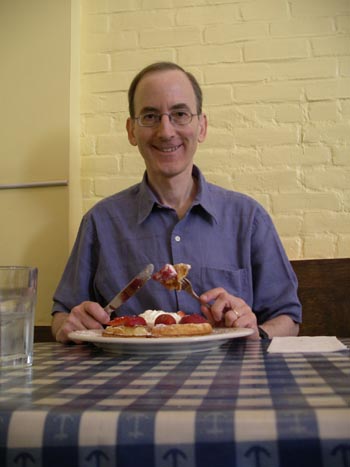 If you’re a fan of Paul O. Zelinsky’s work, you’re in for a real treat today. Not only did he stop by 7-Imp for breakfast this morning, but he is also over at Just One More Book!! today, chatting with, arguably (or probably not arguably), the hardest working bloggers in the kidlitosphere, Andrea and Mark. Oh for heaven’s sake, do NOT NOT NOT miss that podcast, because Mark and Andrea always bring the goods. Plus some.
If you’re a fan of Paul O. Zelinsky’s work, you’re in for a real treat today. Not only did he stop by 7-Imp for breakfast this morning, but he is also over at Just One More Book!! today, chatting with, arguably (or probably not arguably), the hardest working bloggers in the kidlitosphere, Andrea and Mark. Oh for heaven’s sake, do NOT NOT NOT miss that podcast, because Mark and Andrea always bring the goods. Plus some.
And what an honor that he stopped by to chat with us as well. I mean, I’m downright giddy. Over at his website bio, you will read that his first book appeared in 1978 (as well as the fact that, as a sophomore at Yale, he enrolled in a course on the history and practice of the picture book, co-taught by MAURICE SENDAK, whose name I am, yes, yelling, ’cause I find that very exciting), “since which time he has become recognized as one of the most inventive and critically successful artists in the field.” Isn’t that the truth, while also almost sounding like an understatement? How about what Publishers’ Weekly once wrote about him: “Zelinsky is that rare practitioner who can create sophisticated work that adults will marvel at, and that children will joyfully embrace.” Yes, throw in that fan love—adults and children alike—which he has garnered, and…well, you can understand why I’m giddy. He has illustrated or adapted-and-illustrated so many books that we at 7-Imp adore and love and adore some more — as well as lots of other librarians all over the world. Zelinsky has said before, “I’ve…decided that I should be recognized by my unrecognizability.” And some would argue he, indeed, does that well, that his illustrations integrate so well with the text of the book he’s bringing to life with his art, that his versatility is second-to-none. Or, as he once told the Horn Book, he tries to “make the book talk, as it talks to me, and not worry whether it is in my style or not…. I get a kick out of doing each book differently.”
Mary M. Burns also once noted in the Horn Book that reviewing a book Zelinsky has illustrated is both a “pleasure and a challenge.” In reviewing Rumpelstiltskin, which won Zelinsky his second Caldecott Honor (as well as many other honors), she wrote, Zelinsky “has decided to present his version of the familiar Grimm story as fine art through large scale, richly hued oil paintings, notable for careful composition and exquisite rendering of detail” {emphasis mine}, capturing what I think are two of his primary appeals as an illustrator of children’s books, whether he’s working with oils; engineering a book with movable parts; working with what Roger Sutton once called the “woozy perspectives” of The Wheels on the Bus; working with wood-veneer paper, as he did for Anne Isaac’s Swamp Angel (one of the top-ten best picture books ever, in my not-so-humble opinion); fostering a feeling for the beauty of Renaissance art, as he once stated was a goal of his with his beautiful art work in Rapunzel, the 1998 Caldecott Medal winner; or working in black-and-white, as he does in Emily Jenkins’ fabulous stories of the “warm, secret world of toys” (Kirkus Reviews).
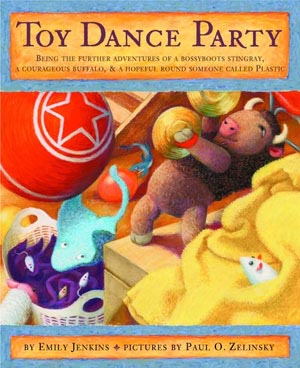 And I’d venture to say that another of the primary appeals of his art work and pretty much any book he’s touched or has had anything to do with is what Kirkus once described as, simply, his “elegant wit.”
And I’d venture to say that another of the primary appeals of his art work and pretty much any book he’s touched or has had anything to do with is what Kirkus once described as, simply, his “elegant wit.”
Zelinsky’s very latest project is Emily Jenkins’ sequel to 2006’s Toys Go Out, entitled Toy Dance Party (both published by Schwartz & Wade Books), which is every bit as wonderful as the prequel (Eisha and I plan to co-review it soon) and is pretty much “specialness forever and ever,” in the words of one of the toys in the book. These are the best talking-toy books since Winnie-the-Pooh, in our not-so-humble opinion here at 7-Imp, and Zelinsky’s half-tone, full-page illustrations in both books are a delight. Here are Plastic and StingRay, attempting to save Lumphy with a spatula and dinosaur placemats, from the rollicking opening chapter of Toy Dance Party, released just this month:
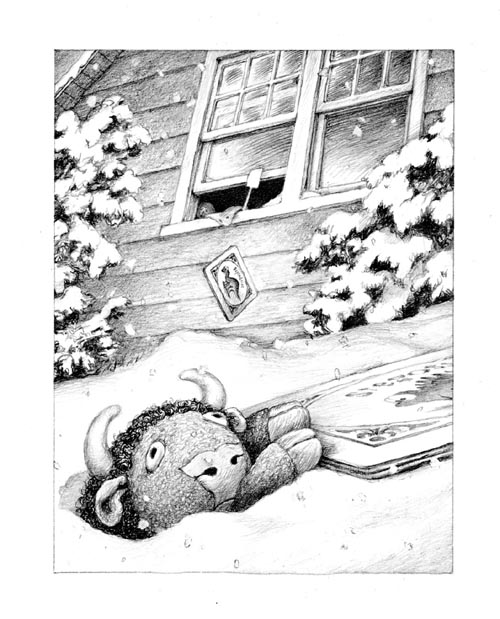
How about Paul and I sit down for breakfast here. His breakfast-of-choice (though you may learn to find out he’s just faking it), if you haven’t already guessed from the opening photo is, “Belgian waffles with strawberries and whipped cream. That’s not too healthy, is it? Then again, I almost never have Belgian waffles. My other breakfast-of-choice, in the sense that it’s what I most often choose, but only out of sloth, is a breakfast of nothing, which isn’t supposed to be healthy, either.” Let’s set the table with some opening questions, and I want to remind you once again to be sure to take in JOMB’s podcast interview with Paul. And that’s because—not only do they always do high-quality interviews—but they also do very detailed ones. And that is what I wish I had done on this interview, not that I’m making apologies for it. I sent Paul my regular seven-questions-over-breakfast illustrator interview format, and I appreciate him taking the time to answer the questions. But my work schedule precluded me from asking him more customized, if you will, questions. So, do take the time to hear JOMB’s podcast, as I’m sure they chatted details with this immensely talented man.
7-Imp: Are you an illustrator or author/illustrator?
Paul: Basically illustrator, but I have adapted various things, so you might call me an Illustrator-Adapter. Though I hope you don’t.

7-Imp: Can you list your books-to-date?
Paul:
Most recent:
- Emily Jenkins’ Toy Dance Party
- Jack Prelutsky’s Awful Ogre Running Wild
- Fran Manushkin’s The Shivers in the Fridge
Best known:
and others.
{Ed. Note: Visit this page of Paul’s site for a complete bibliography.}
 7-Imp: What is your usual medium, or -– if you use a variety -– your preferred one?
7-Imp: What is your usual medium, or -– if you use a variety -– your preferred one?
Paul: I don’t think I prefer one. I’ve used oil paints more than anything else, though.
7-Imp: If you have illustrated for various age ranges (such as, both picture books and early reader books OR, say, picture books and chapter books), can you briefly discuss the differences, if any, in illustrating for one age group to another?
Paul: I think that if a text has been well written for a particular age range (assuming such a thing exists) and if I follow the feel of it in the pictures, my illustrations will turn out also to be appropriate for that range. On the other hand, I’ve been surprised that many children have taken to certain books of mine when I would have thought they were too young to appreciate them. For instance, Rapunzel seems to appeal to at least some very young people. For me, it’s all about the feelings I’m trying to access with my pictures—feelings do sort of come with age-associations attached to them (if that makes any sense).
7-Imp: Where are your stompin’ grounds?
Paul: In Brooklyn Heights, New York, the neighborhood I first moved to when I moved to New York City; where I met my wife, and which I have never left.
7-Imp: Can you briefly tell us about your road to publication?
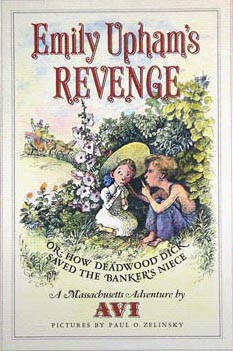 Paul: Art major in college, but I dabbled in illustration, and did work for the New York Times on the side. I planned to become a college art teacher, but found out when I began that career that teaching wasn’t my strong point, and I knew deep inside that book illustration probably was. So I moved to New York and showed my portfolio around until I was given my first book to illustrate.
Paul: Art major in college, but I dabbled in illustration, and did work for the New York Times on the side. I planned to become a college art teacher, but found out when I began that career that teaching wasn’t my strong point, and I knew deep inside that book illustration probably was. So I moved to New York and showed my portfolio around until I was given my first book to illustrate.
7-Imp: Can you please point us to your web site and/or blog?
Paul: www.paulozelinsky.com. No blog.
7-Imp: If you do school visits, tell us what they’re like.
Paul: They’re a lot of fun, at least for me! I generally tell about the origins and the creation of a single book in a presentation, and in my computer I have material on almost all of my books. There are always fascinating aspects to the making of a book, and many ways to look at and think about things; my presentations are about that, and mostly not very autobiographical. Sometimes the presentations have snazzy PowerPoint tricks in them, and I always demonstrate points by drawing, either in charcoal at an easel, or else into my digitizing tablet (using Photoshop) and out through the LCD projector. I’ve heard that people are sometimes surprised to discover that I can be funny. In the distant past, many people said they were surprised to find I was so young, but for some reason this seems to have stopped happening.
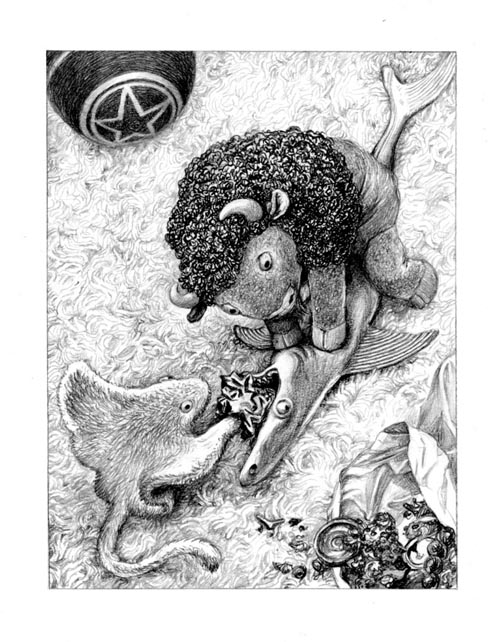
7-Imp: If you teach illustration, by chance, tell us how that influences your work as an illustrator.
Paul: I don’t teach. The most I’ve done is make a guest appearance in classes taught by others.
7-Imp: Any new titles/projects you might be working on now that you can tell us about?
Paul: The sequel to Anne Isaac’s Swamp Angel. It’s called Dust Devil (the name of Swamp Angel’s new horse).

 Okay, the table’s set. Paul’s got his Belgian waffles, and I’ve got my coffee. We’re ready to sit down and talk more specifics. Many thanks again to Paul for stopping by…
Okay, the table’s set. Paul’s got his Belgian waffles, and I’ve got my coffee. We’re ready to sit down and talk more specifics. Many thanks again to Paul for stopping by…
1. 7-Imp: What exactly is your process when you are illustrating a book? You can start wherever you’d like when answering: getting initial ideas, starting to illustrate, or even what it’s like under deadline, etc. Do you outline a great deal of the book before you illustrate or just let your muse lead you on and see where you end up?
Paul: I can’t imagine just sitting down and letting things flow as a way to illustrate a picture book. What you want to create is a set of a certain number of double page spreads that include an already-written text, which is a very important part of the book design (not to mention an important part of the book). So how the text is broken up, where it’s placed on each page, and how much space it occupies are all inextricably related to picture-questions, like what gets shown on what page, how much of a page each picture fills, and how the compositions are going to work from one spread to the next. It often takes a lot of juggling to get something right, and this is before the picture-making ever begins. I actually feel at my most creative when I’m breaking a text into pages to try to fit it into the thirty-two or sometimes forty pages available for a picture book. You can see that I’m pretty analytical, but that’s just part of it; I do get into a sort of groove, even a slightly trance-like state, once ideas start coming. Doodling around to find what the characters should look like becomes a little sideline that occupies me when I’m doing something else. And those are probably the two major parts of getting a picture book into shape, even though making finished art is the most time-consuming part and, for me, the hardest.
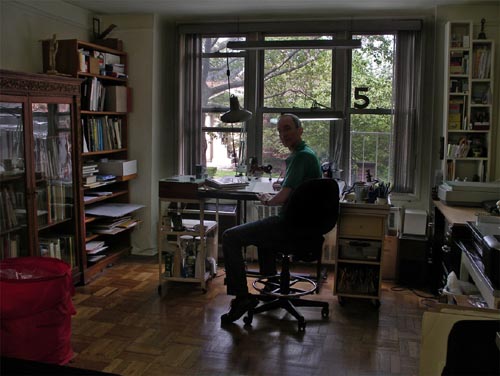
2. 7-Imp: Describe your studio or usual work space for us.
Paul: I work in a one-room apartment a couple of blocks from the apartment where my wife and I live. Our neighborhood is a wonderful, historic district in Brooklyn, full of nineteenth-century brownstone houses, though my studio is in an ugly mid-20th-century building with low ceilings and the kind of poor construction that wasn’t invented until the 1960s. But directly across the street from my windows is a beautiful churchyard behind a low, wrought-iron fence (I put its elegant gate, sort of, into a zoo scene in the just-published Awful Ogre Running Wild by Jack Prelutsky). The church complex houses a preschool, so my view often includes tiny children running around on the grass. I have my drawing table looking straight out the window. Also in my studio are lots of shelves of things, and a wall for hanging current finished art, which is currently empty; a couch with flat file drawers, made for me in birdseye maple by a boatbuilder friend; and a bed, because this studio is also our guest room.
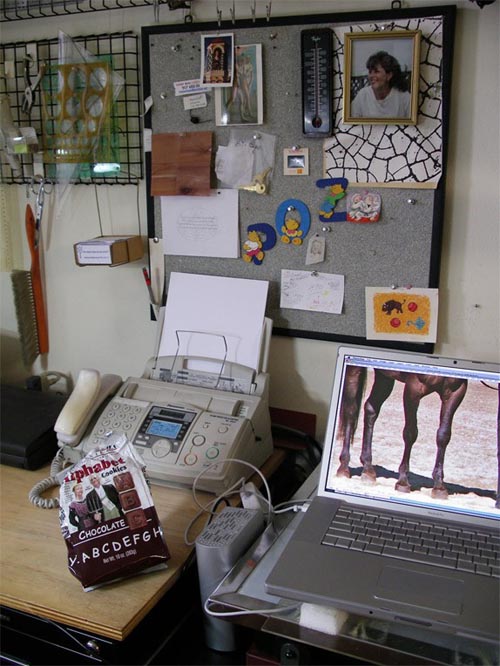

3. 7-Imp: As book lovers, it interests us: What books or authors and/or illustrators influenced you as an early reader?
Paul: Robert Lawson, William Pène du Bois, various illustrators of the Little Golden Books of the 1950s. The first couple of Oz books (not for the pictures, though). Doctor Doolittle. For a while, I was crazy about the few books I could find written and illustrated by a man whose name and books I just can’t remember. The one I’ve forgotten least was called “The Tarsier’s … [something or other]”.
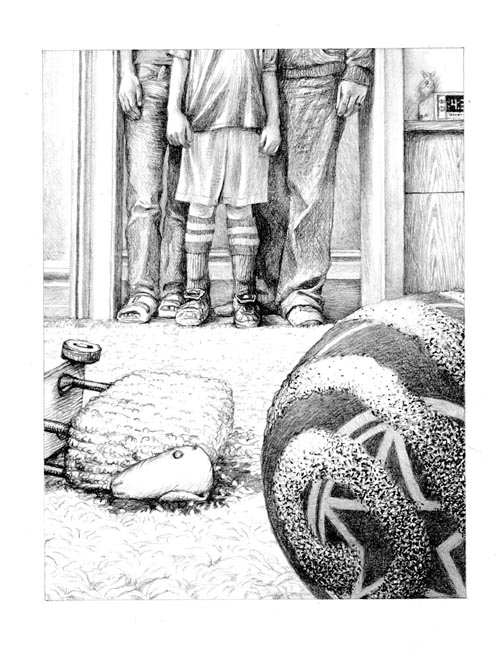
4. 7-Imp: If you could have three (living) illustrators or author/illustrators—whom you have not yet met—over for coffee or a glass of rich, red wine, whom would you choose?
Paul: This is a poser and kind of embarrassing—I’m having a hard time thinking of people I most admire in this field whom I haven’t ever met (and who are alive). I’ve often been amazed by how many incredible illustrators and authors I’ve been introduced to at one function or another (and every one of them was alive). Well, there’s Tomi Ungerer; and then… ? I’m sure I’m forgetting ten obvious choices. Forgetting things is one of my major talents.
5. 7-Imp: What is currently in rotation on your iPod or loaded in your CD player? Do you listen to music while you create books?
Paul: I can’t work if I’m listening to music. And to tell the truth, I don’t get that much from listening to music when I’m not working. I don’t even have an iPod or a CD player. Often I work to talk radio, or when I remember that it’s possible, to podcasts that seem interesting, but just as often I’m at work with nothing but ambient noises—the children across the street, or the drone of distant traffic and the occasional helicopter or car going by.
6. 7-Imp: What’s one thing that most people don’t know about you?
Paul: They don’t know about my tattoo. My tattoo is a tiny dot near a knuckle on my left hand, where I reached for a pencil in a pencil jar once, and impaled my finger on an upward-pointing, very sharp dip-pen that had dried ink on it.
7. 7-Imp: Is there something you wish interviewers would ask you — but never do? Feel free to ask and respond here.
Paul: “How are your beautiful wife and daughters?”
“Very well, indeed, thank you!”

7-Imp: What is your favorite word?
Paul: I am really hopeless at naming favorites. Not only do I have a hard time choosing a favorite anything, I usually don’t see the point in doing it*. Everything is apples and oranges to me. But a favorite word…
If you forced me to choose something, I’d choose the word “zymurgy.” That’s the last word in my dictionary; it means the science of fermentation, and the reason I favor it (apart from a certain fondness for the tail end of the alphabet) is that I used to use it to break up arguments that my two daughters, four years apart, kept getting into when they were young. Whatever the argument might be, it would never end, because each girl had to get in the last word. So whenever they got into a silly and unending dispute, I’d try to get them both to say “Zymurgy!” and then they would have to stop arguing because they’d had the last word. I thought this might at least distract them to the point where they could stop and look at what they were doing and put the brakes on. I don’t remember it working, but we all remember the word.
There was another word even later in the alphabet from another dictionary: “zyzzogeton,” which is the name of some sort of insect, but I liked “zymurgy” better. There, I chose a favorite.
(*– when I chose a breakfast favorite, I was sort of faking it. I used to have favorite things when I was young, and Belgian waffles did become my favorite breakfast after I tasted them at the 1964 New York World’s Fair, in the Belgian pavilion. The present-day me wouldn’t be able to decide that that breakfast is really better than good croissants, or my mother’s fried matzoh, or …).
7-Imp: What is your least favorite word?
Paul: I was going to say “favorite.” But that may be overstating it. Maybe my least favorite word is “cancer.” Or “corruption.” Words from the beginning of the alphabet, you know. No offense meant to the A and B people of the world.
7-Imp: What turns you on creatively, spiritually or emotionally?
Paul: Natural beauty. Often just the clouds in the sky. Or really good food. And wonderful art, for sure. Please don’t ask my favorite!
7-Imp: What turns you off?
Paul: Pettiness. Sentimentality.
7-Imp: What is your favorite curse word? (optional)
Paul: “##@&°‡‹!!!”
But that’s a “favorite” question.
7-Imp: What sound or noise do you love?
Paul: The sound of chocolate syrup pouring down over ice cream.
7-Imp: What sound or noise do you hate?
Paul: Total silence. A sudden gasp.
7-Imp: What profession other than your own would you like to attempt?
Paul: I would have liked to be a physicist or someone investigating why the physical world works the way it does. Or a neuroscientist investigating what is taking place in our brains to allow us to think we see or hear or know anything about the physical world.
7-Imp: What profession would you not like to do?
Paul: Professional stuntman.
7-Imp: If Heaven exists, what would you like to hear God say when you arrive at the Pearly Gates?
Paul: “You only have to spend a little while here, and then you can go back!”
Art from TOY DANCE PARTY. Illustrations copyright © 2008 Paul O. Zelinsky. Reproduced by permission of the publisher, Schwartz & Wade, New York.
All photos courtesy of Paul O. Zelinsky. Posted with permission. All rights reserved.

[…] Great minds think alike: Once again our 7imp buddies and ourselves have a common guest. Be sure to check out Paul O. Zelinsky’s visit with Jules & Eisha today on Seven Impossible Things Before Breakfast. […]
Ohhh! I still have my very own Dear Mr. Henshaw. I LOVE, love, love that book. And many of my fifth graders who were reluctant readers were allowed to use Dear Mr. Henshaw for a jump start on a journaling exercise.We all loved reading his name: “Zelinsky” is even fun to say.
I like the looks of those fairytale retellings, Rapunzel and Rumplestiltskin — and the Swamp Angel — that one looks really cool. Thanks for sharing this great illustrator with us.
A studio with a couch AND a bed? I could serial nap there!
I love his favorite sound. And his dislike of choosing favorites. And his wanting to be a physicist. But mostly, I love his gorgeous work.
Sara and TadMack, I KNOW! What a treat to have him here. Sara, I have been WAITING for someone’s favorite curse word to be “$#%&*^”…I love it.
This interview makes me want to get EVERYthing he’s ever done and re-discover all the great books and beautiful art.
Oh Jules, this fabulous, personal glimpse into the life and mind of this talented, warm, humourous, genius. I am just stunned that some one as successful and accomplished and worshipped etc etc as Paul O. Zelinsky not only takes the time for such thoughtful, intimate and witty responses but sets the scene with photos just for you (well, for all of us 7imp groupies).
This interview is the perfect example of why we all knock ourselves out to be part of this huge online celebration of children’s books and those creative and lovely people who are behind them.
Thanks so much for this. It’s a great start to my week (well, except for crying at Paul’s response to the heaven question, which I know for sure I haven’t yet finished and will likely keep my weepy all day…)
that was supposed to start. “Thanks for this” — no idea where my Thanks for went….
anyway THANKS
Great interview. I love Paul Zelinsky’s work! (AND I wish I lived in Brooklyn Heights, too.)
One question I’m always curious about — if Paul Z is reading this, I hope he’ll chime in… When I was a boy, one of my best friends (who grew up to be an art teacher) was a talented artist/cartoonist, and I loved to watch him at work. For many reasons, but especially this: As he drew people, his own face took on the expressions he was trying to capture. He didn’t use a mirror or anything — I think the habit was unconscious. Anyway, I’m curious if other artists do the same thing (in the absence of a model, of course).
I love the explanation for his favorite word. And I really adore his work.
I saved this interview as a reward for finishing my work today. All through it, I was hyperventilating, and could only manage ohs, ahhs, eees, and wow oh wows. He’s one of those people whose work is on another plane. A very high one.
In a category all by itself. So good, so, so good.
Not to mention the Belgian waffle, chocolate syrup on ice cream, and that bag of Newman’s chocolate alphabet cookies. Did you SEE that?! I love this man.
Thank you so much, Jules!!
Fantastic anecdotes (especially zymurgy!) from a wonderful illustrator. Thank you, Paul, especially for the cover of Dear Mr. Henshaw, and for the recent delights of depicted in Emily Jenkins’ Toys books. So adorable.
Zelinsky has this amazing ability to often his tones which is really a tribute to his patience to do the perfect piece of work in my opinion. He also makes the most hilarious Facebook profile images.
Wonderful interview! LOVE his work — and love love love that last line!
I love his work!!! TOYS GO OUT wouldn’t be the same without his beautiful artwork.
And yum – now I want waffles with strawberries! 🙂
Oh, I so loved this! Yay!
Thanks, you all! What an honor to have him stop by, huh?
wow. thank you for sharing your thinking and insights. http://www.debrennersmith.com
[…] Paul O. Zelinsky (interviewed September 29), pictured below, on school visits: “I’ve heard that people are sometimes surprised to […]
[…] Here’s another great interview with him on the always great, Seven Impossible Things Before Breakfast. […]
I have been flattered to pieces by these comments. But I just want to add something relating to Question #4 (if I could meet an author/illustrator I haven’t met, where I mentioned Tomi Ungerer). In June, Tomie Ungerer came through New York for the first time in many, many years; he spoke and signed at Books of Wonder bookstore, and I met him. That night, on a whim, I thought I’d see if he was on Twitter, and to my surprise, he was. To my utter delight, on June 12th, 2011, Tomi Ungerer started following me! (@paulozelinsky, if you’re interested).